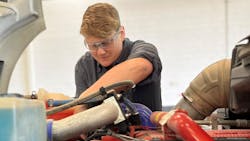Experts share how to increase number of female techs in the vehicle repair industry
Technicians are already scarce in the commercial vehicle repair landscape, and female technicians are even scarcer. But with the needs of the commercial vehicle maintenance sector ever increasing, 50.4% of the population offer an untapped resource to the industry, a fact which many are beginning to realize as female technicians make waves in the profession. For example, FedEx Freight technician Bonnie Greenwood came in second in 2022's TMCSuperTech the annual American Trucking Associations’ Technology and Maintenance Councils’ National Technicians Skills Competitions, and her example has not gone unnoticed.
In a recent press release, the Women in Trucking Association (WIT), a non-profit that encourages female participation in the trucking industry, stated in their 2023 WIT Index of women in the industry that on average, 7.5% of technicians were women, an increase of 3.8% from 2022 to 2023.
Read more: The 2% solution to the tech shortage
While this increase seems small, particularly in the face of how WIT also reported that 49.6% of shops have no female techs on the floor, this growth is still significant, especially when compared to the amount of female automotive technicians at large. According to Zippia, the largest percentage change of female techs in the auto industry in recent years was just over 3.1% from 2016-2017. This makes WIT’s number not only comparable, but encouraging, especially for the women already engaged in the industry.
This is the case for Missy Albin, a senior lead technician at Taylor & Lloyd who appeared on a panel at the 2022 ASE Instructor Training Conference that focused on how to bring more women to the trade.
“Having that conversation and then seeing what happened a year later is very exciting for me, because it seems like there is a lot of organizations out there that are trying to prepare and learn how to recruit and retain [women],” Albin explained.
The key is to keep this momentum going to alleviate both the gender disparity and the technician shortage in the industry. Doing so means understanding why the number of female technicians increased over the past year, how to ensure they keep coming, and recruitment and retention challenges.
Why the number of female technicians increased
For some women, such as Cindy Barlow, director of industry outreach at WyoTech, an automotive, diesel, and collision trade school based in Laramie, Wyoming, the increase in female technicians can be attributed to a better public understanding of the benefits of technician’s role.
“Because of the overall knowledge of the trades and the opportunities that are available out there with a recession-proof job, women are looking at [technician roles] and going ‘Listen, I can do this and I'm passionate about working on cars,’ and they've decided that this is a viable career choice for them,” Barlow explained.
Albin agreed, calling herself a strong proponent of marketing and PR and noting that this kind of public encouragement can not only introduce younger women to the trade, but compel older women to change careers entirely.
“I've spoken to so many women that have come into the diesel industry or started wrenching in the auto industry, and they're 30 to 40 years old,” Albin noted.
Part of this public reach is due to technicians like Albin and Greenwood, who are public sources of inspiration to other female technicians
“There’s an element of ‘monkey see, monkey do,’” said Morgan Woodtke, diagnostic technician at Allegiance Trucks in Torrington, Connecticut. “Women who are potentially interested see a few very successful women in the industry and it's an inspiration for them to start.”
Woodtke herself has served as a guide to young women taking classes at her alma mater, Lincoln Technical Institute.
Additionally, successful female techs have not only inspired other women to follow in their footsteps, but encouraged the industry to broaden its hiring practices, too.
“When you talk to industry partners, they're focusing on female talent because they see that they're so thorough in what they do,” WyoTech’s Barlow commented. “Now that they're getting to see those results, they’re pushing for more of them and recognizing everything that women have to offer.”
How to keep women coming to the industry
To keep this trend going, Barlow contends that the technician trade needs more support, especially in public education where students are often pushed towards four-year colleges instead of the trades.
“[Recruitment] has to start younger, it has to start in high school,” Barlow affirmed. “Our public education system has to be better about teaching the trades, making sure that they have good programs in high schools, making sure that they support those programs, and partnering with the industry to be a part of those programs so that they can direct these kids toward viable opportunities.”
This, of course, includes making sure that girls are encouraged and welcomed in these programs too, from welding to diesel technology to small engine courses.
“I believe promoting trade schools will help the percentage grow, but at the same time, we shouldn't push women to do it,” Woodtke cautioned. “If they want to do it badly enough, they will.”
The retention problem
While Barlow, Woodtke, and Albin all agreed that recruitment practices for female technicians are improving, it’s retention that needs the most work. But this can be difficult because it’s up to each individual shop and dealer to make sure that their female employees are treated equally as their male counterparts.
“We have a tendency of making it look a lot better than it is,” Barlow admitted. “The reality is, when women get to the shop floor, we have a tendency of treating them differently. We don't give them the opportunities to grow, we treat them as though they can't handle the heavy lifting. They have the knowledge, they have the ability, and when they see that they're being limited in their opportunities in a shop, they choose to leave.”
Albin agreed, describing how she’s had five friends, all female diesel mechanics, shift into different careers in the past year alone, often because of the differential treatment they received on the shop floor.
Even when this treatment might seem positive, such as if a shop lauds their one female mechanic in job posts and on social media, this too can drive talent away.
“The problem with recruitment and retention techniques is that they essentially single women out or divide us into our own group,” Woodtke observed. “Why do I have to be a great ‘female diesel mechanic’ when I could just be a great diesel mechanic?”
Additionally, Woodtke noted that the attention to female technicians may have the adverse effect of attracting applicants who are more interested in the popularity of the job than the trade itself. When that happens, “the talent in the female pool is diluted,” Woodtke said. Then “many of them don’t stay because it’s not all that it was made out to be, and that’s where the loss of retention is.”
Keeping women in the technician trade means creating a work culture where women are welcome at every level of dealers and shops, Albin said, a process that is neither easy nor quick. But beginning to do that work now could pay off in addressing the technician shortage and ensuring that women are no longer a 2% solution, but a 50.4% one.
About the Author

Alex Keenan
Alex Keenan is an Associate Editor for Fleet Maintenance magazine. She has written on a variety of topics for the past several years and recently joined the transportation industry, reviewing content covering technician challenges and breaking industry news. She holds a bachelor's degree in English from Colorado State University in Fort Collins, Colorado.
